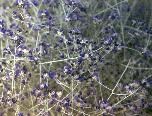
PETR/NPS Prickly Pear Opuntia phaeacantha The edible fruits of this plant are called "tunas" and were one of the few sweets the native people enjoyed before the arrival of Europeans and the introduction of the common fruits we eat today. 
PETR/NPS Purple Aster Machaeranthera spp. These flowers are found widespread in New Mexico during the fall. A concoction of leaves and stems was used by native peoples as a stimulant, especially effective for women in labor. Tea from the ground plant was used to treat upset stomachs. 
PETR/NPS Fourwing Saltbush Atriplex canescens Native people ground and cooked the seeds of this plant as a cereal; the leaves were dried and mixed with other ingredients for flour. Ashes of burned saltbush were used as a leavening for breads. 
PETR/NPS Broom Dalea Psorothamnus scoparius This tall shrub (sometimes called Purple Sage) has many branches, and is characterized by leaves with only one leaflet, and intense purple flowers. 
PETR/NPS Cane Cholla Opuntia imbricata Cholla buds are high in calcium. Local native peoples ate the fruit raw, stewed or dried and ground into flour. The woody skeleton has been used for walking sticks or tied together to make fences. 
PETR/NPS Jimsonweed Datura meteloides This highly poisonous perennial plant has a history of ceremonial use by native peoples throughout the Southwest. 
PETR/NPS Sand Sage Artemisia filifolia This aromatic plant has many medicinal uses. Boiled in water, the steam can be inhaled as a decongestant; as a tea it is believed to cure stomach disorders. 
PETR/NPS Scorpion Weed Phacelia integrifolia This plant has been used medicinally by local native peoples. The powdered root or leaves are mixed with water and rubbed on sprains, swellings and rashes. 
PETR/NPS Spectacle Pod Dimorphocarpa wislizenii This herb is a member of the mustard family. The fruit of the plant is flat and resembles a pair of spectacles. 
PETR/NPS Snakeweed Gutierrezia sarothrae This medicinal plant is used in a variety of ways by local native peoples. Used in poultices and as a tea it is said to be useful in treating rheumatism, rattlesnake bites, eye problems, bruises, aching muscles, colds and sore throats. 
PETR/NPS Curly Dock Rumex hymenosepalus This plant is also known as Wild Rhubarb. The stems and leaves are high in vitamins A and C. Local native people boiled and served the leaves much like spinach and also cooked and ate the rhubarb stems . 
PETR/NPS Globemallow Sphaeralcea angustifolia Remnants of this plant have been found in many archeological sites in the Southwest. It was used in several ways including, chewing the stem like gum, a cure for dysentery, and smoked as a replacement for tobacco. |
Last updated: August 4, 2024
